BLENDEN LEARNING IN PROFESSION-ORIENTED ENGLISH TEACHING IN THE POST- AND METAMODERNISM
DOI:
https://doi.org/10.32782/apv/2022.1.2.16Keywords:
Blended learning, innovative educational space, Postmodernism, Metamodernism, Professionally- Oriented English, tradition, decentering, osculation, ICT, foreign communicative competenceAbstract
Article’s relevance is predetermined by the modern sociocultural situation in the world that inevitably influences educational space as well, establishes its own standards and requirements, determines teaching strategic directions, set the learning vector and teaching-educational processes, govern the priority points of education development in general. The key principles of post- and metamodernist ideas implementation in today’s educational paradigm are described. In the given paper, the emphasis is laid upon the rapid expansion of these ideas in the present-day educational systems and its reflection on the spontaneous teaching process transformation, pedagogical thesaurus updating, the appearance of new teaching hybrid forms and didactic theories. It is reported that the frequent use of post- and metamodernist conceptual approaches form the background of the whole educational sphere innovative activity. Further, the author reports on how challenging is to set a dialogue between the tradition and innovation to synthesize completely new educational products. The article goes on to say that it is important to combine (modernist)traditional approaches, that mold the educational core, with best teaching practices and ICT in the context of the Blended learning models in the process of Professionally- Oriented English teaching. Much attention is given to the modern educational content analysis through the lens of conceptual truth of postand metamodernist that are presented in the categories of pluralism, individualism, multiculturalism, interactivity, eclecticism, deconstruction, disclosure, heterogeneity, dialogue, oscillation. The article provides insight into the tradition/ innovation correlation and depicts how it enables the possibility of the learning repository and toolbox extension to recombine educational functions, to create individual learning paths in the within the Blended learning context.
References
Бодрийяр Ж. Система вещей. Москва : Рудомино, 2001. 224 с.
Гранин Ю.Д. Глобализация и образование. Социология. 2004. № 3–4. С. 166–172.
Делез Ж. Логика смысла. Москва : Академия, 1995. 298 с.
Эко У. Имя розы. Санкт-Петербург : Симпозиум, 2007. 632 с.
Квієк М. Глобалізація і вища освіта. Вища школа. 2001. № 4–5. С. 107–117.
Кікоть Г.В. STEM-освіта як засіб формування критичного мислення учнів на уроках англійської мови. Таврійський вісник освіти. 2019. Вип. 1. С. 62–69.
Красновицький М., Бєлкіна О. Проблеми виховання критичного мислення учнів у контексті теорії і практики американської школи. Рідна школа. 2003. Вип. 2. С. 73–76.
Лиотар Ж. Состояние постмодерна. Санкт-Петербург : Алетейя, 1998. 160 с.
Маньковская Н.Б. Эстетика постмодернизма. Санкт-Петербург : Алетейя, 2000. 347 с.
Deleuze G., Guattari F. Rhizome. Introduction. Paris : Éditions de Minuit, 1976. 74 p.
Kincheloe J. Toward a critical politics of teacher thinking: Mapping the postmodern. Westport : Praeger, 1993. 280 p.
Orenstein A.C., Hunkins F.P. Curriculum – foundations, principles, and issues. Needham Heights, MA : Allyn and Bacon, 2003. 188 p.
Vermeulen T., van den Akker R. Notes on metamodernism. Aesthetics & Culture. 2010. vol. 2. Р. 1–14. URL: http://metamodernizm.ru/notes-on-metamodernism/







